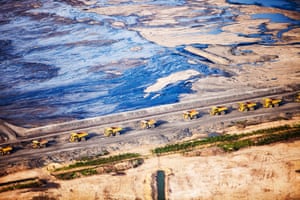 |
| Alberta, Canada: The destructive quest for oil has turned this into a toxic wasteland. Above, dump trucks queue up to load with tar sands. |
 |
| Manchester, UK: Rush hour traffic on the M60 motorway at sunset. Consumption of one gallon of petrol emits around 10.2kg of C02. |
 |
| Suihua, China: Heavy use of coal in a slum in Suihua, Heilongjiang, pumps out smoke into an already highly polluted atmosphere. Rates of heart and lung disease, and breathing difficulties are commonplace in Chinese cities, that are among the most heavily polluted in the world. |
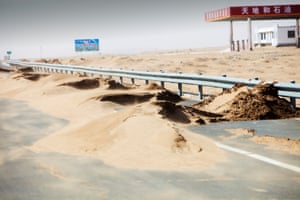 |
| Inner Mongolia, China: Creeping desertification with sand dunes spreading across the highway. |
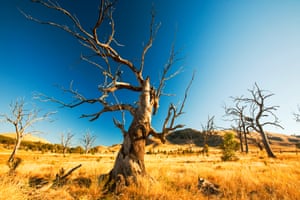 |
| Forest ghosts: Lake Eildon in Victoria, Australia was built in the 1950's to provide irrigation water, but the last time it was full was in 1995. The day the shot was taken it was at 29% capacity with levels down around 75ft. The trees that were drowned and killed when the reservoir was first filled now stand well clear of the water. |
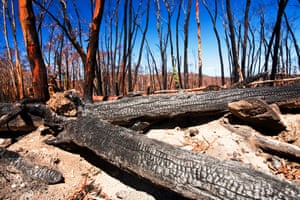 |
| Forest destroyed by bush fires near Michelago, New South Wales, Australia. |
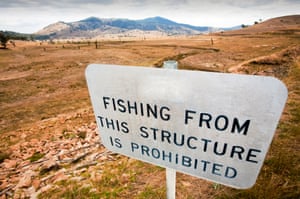 |
| Where has all the water gone?: Lake Hume is the largest reservoir in Australia and was set up to provide irrigation water for farms further down the Murray Basin and drinking water for Adelaide. On the day this photograph was taken it was at 19.6% capacity. By the end of the summer of 2009 it dropped to 2.1 % capacity. Such impacts of the drought are likely to worsen as a result of climate change. The last time the water was anywhere near this road bridge was 10 years ago, rendering this no fishing sign, somewhat redundant. |
 |
| A young man cycles through flood waters in Toll Bar, South Yorkshire, UK. |
 |
| A farmer's sign about the water crisis near Bakersfield in the Central Valley, California, US, with the soil turned to dust. The whole of California is in a catastrophic drought with $2bn annually lost from the agricultural sector. |
 |
| Scientist Ian Bartholomew uses dye tracing techniques as part of a study to measure the speed of the Russell Glacier near Kangerlussuag in Greenland. The study looks at how increasing quantities of melt water caused by climate change are affecting the glacier's speed, which has sped up in the last 20 years. Reflective poles were drilled four metres into the ice to measure their speed at various points on the glacier. Within a month all the poles had fallen over as the glacier melted down. |
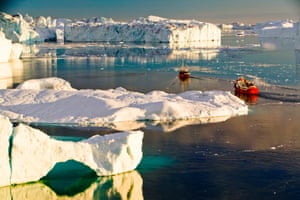 |
| Tourist boat trips sail through icebergs at midnight from the Jacobshavn glacier, Greenland. |
 |
| A male polar bear that starved to death as a consequence of climate change. Polar bears need sea ice to hunt their main prey, seals. Western fjords of Svalbard which normally freeze in winter, remained ice free all season during the winter of 2012/13, one of the worst on record for sea ice around the island archipelago. This bear headed hundreds of miles north, looking for suitable sea ice to hunt on before it finally collapsed and died. |
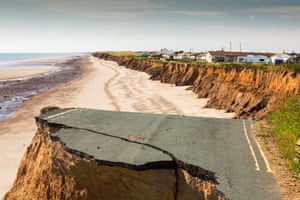 |
| A collapsed coastal road between Skipsea and Ulrome on Yorkshire's east coast, UK. This section of coast is composed of soft boulder clays and is the fastest eroding coast in Europe. It has been eroding since Roman times and many villages have disappeared into the sea. Climate change is speeding up the erosion, with sea level rise, increased stormy weather and heavy rainfall events, all playing their part. |
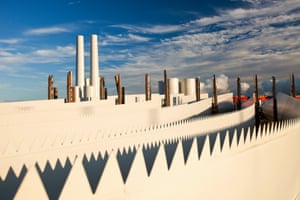 |
| The huge blades to be used at Walney offshore wind farm in Cumbria, UK. The serrations help to control the air flow over the blade for greater efficiency and extra power. |
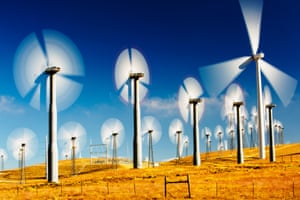 |
| Part of the Tehachapi Pass wind farm, California, the first large scale wind farm area developed in the US. |
 |
| The PS20 solar thermal tower. Its is part of the Solucar solar complex owned by Abengoa energy, in La Mayor, Andalucía, Spain. The site has a solar tower, parabolic trough and photovoltaic solar technology on the complex. |
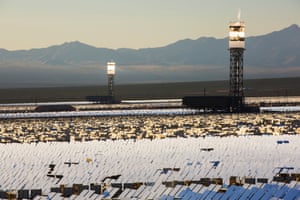 |
| Two of the three solar towers and heliostats at Ivanpah solar thermal power plant in California's Mojave Desert, US. |
 |
| Workman preparing to tow a Pelamis P2 wave energy generator on the dockside at Lyness on Hoy, Orkney Isles, Scotland. The Orkney's have huge potential for wave and tidal energy generation and are world leaders in testing such devices. The pelamis P2 is 180m long, weighs 1,300 tonnes and is rated at 750 Kw. It was the world's first commercial scale marine device to generate electricity to the grid, from offshore. |
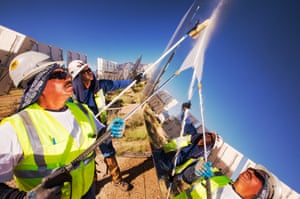 |
| Workers washing the heliostats to maximise reflective power at the Ivanpah solar thermal power plant. |
 |
| A women welding joints during the construction of a solar cooker at the Barefoot College in Tilonia, Rajasthan, India. |
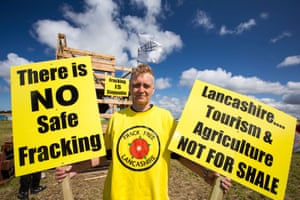 |
| A protestor against fracking at a farm site at Little Plumpton near Blackpool, Lancashire, UK. |
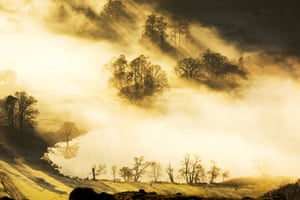 |
| Looking down on to Loughrigg Tarn above valley mist, one of many clean, freshwater bodies in the Lake District national park, UK. |



No comments:
Post a Comment